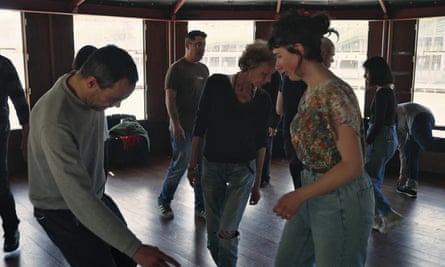‘I’d be a wreck without it’: the floating daycare centre where Parisians paint, dance and heal
The Adamant is both the setting and the star of the film that won director Nicolas Philibert a surprising top prize at this year’s Berlin Film Festival. But in his compelling documentary, this institution – a floating daycare center for people with mental health problems moored on the River Seine – somehow remains something of a mystery. Philibert’s slow, unassuming films don’t use narration, and in the absence of a contextualizing voice, one might assume that inviting potentially vulnerable patients into a center surrounded by water is a terrible idea.
Only when you walk over the metal gangway and enter the ship’s length reception area does the concept begin to make sense. Eric Piel, the psychiatrist who conceived the Adamant and oversaw its construction in 2010, insisted that the center should have as few walls as possible (the only doors I opened in the four hours I was there were those to the room of a therapist and the toilet). The three-story space feels surprisingly airy: sunlight reflects off the water and streams through the louvered windows, painting animated squiggles on the wood paneling. The screeching traffic on the three-lane Quai de la Rapée and the bickering drunks under the Pont Charles-de-Gaulle sound far away. It is a place that calms the nerves.
There is also something about being on the water that gives you a greater appreciation for your fellow human beings. As Philibert, a softly spoken, spiky-haired 72-year-old man, shows me around the grounds and a passing tour boat rocks the waves, I reach out to hold my guide. “We are in the center of Paris,” he says, “and yet we feel like we are somewhere else. It is a very soothing, healing place for everyone. Not only for patients, but also for filmmakers.”
The cool, Victorian-sounding name of The Adamant symbolizes the centre’s determination to go against the currents of the times. “For more than 25 years, psychiatry in France has faced budget cuts and the merger of sectors,” said Arnaud Vallet, the lean and intensive head nurse at the state-funded center. “So the idea is to undermine this deadly economic logic.”

The 230 ‘passengers’ (Philibert prefers this term to ‘patients’) come from the first four arrondissements of Paris. Upon referral from their doctor or therapist, they can visit us from Monday to Friday between 9:15 AM and 5:00 PM. Most start with a strong coffee from behind a recycled counter. They can then participate in music, radio, drawing, painting or stained glass windows workshops, organized by the center’s 25 employees. Once a week the passengers cook together and on Friday afternoon there is a film club.
after newsletter promotion
“If there is a mission here,” says Philibert, “it is to provide people with some form of care. But that doesn’t mean they will be healed. The goal is to restore the passengers’ ability to exist in life and in society, while preserving their individuality.”
Such an approach – enabling people with mental illness to participate in everyday life through meaningful activities, also known as occupational therapy – is hardly new. What makes the floating day center on the Seine different, however, is its emphasis on creativity. “The connections the passengers have with the world are extremely fragile,” says Philibert. “Maybe the way to strengthen them is to do activities that prevent boredom and keep their desire alive.”

During the Renaissance, mentally ill people in Central Europe were reportedly taken aboard a ‘ship of fools’ and effectively exiled, sent on permanent journeys through the rivers of the Rhineland and the Flemish canals. The Adamant, on the other hand, is permanently moored in the center of Paris (where the engine would have been) there is a library. By the end of the film, the center comes across more as a cool private members club for talented outsider artists than a place that society wants to ignore. If you’d like to join the crew, you won’t be alone: during my visit, novelist Marie Darrieussecq will drop by to discuss a joint project.
The boat’s name, Vallet explains, also references Adam Ant, the British singer diagnosed with bipolar disorder, and most of the film’s regulars have rock star qualities. Take François, whose intense and brilliant rendition of the 1979 pop song from Téléphone La Bombe Humaine gives the film a showstopper in the very first scene. There is also the stoic Patrice with the white hair, who starts every day by writing a poem in the Adamant’s cafeteria – and ends by typing out his verse at home. Then there is Catherine, a dancer who is constantly on the balcony of the boat and eventually explodes with frustration because she is not allowed to run her own studio.
They all have problems. “Only the medicines ensure that I no longer think that I am Jesus,” says François, whose gaping teeth speak of less happy times. But we never see the passengers in their dire condition. Instead, Philibert’s interviews suggest that their ability to experience art in a sideways, more intense way might actually be a blessing. Alexis, a young man with a chinstrap beard, lives in a world of hyperactive associative thinking where every word produces an image. “Very tall, skinny men,” he says, “they remind me of ‘injection’. A bald man reminds me of an orange.” Another passenger is extremely sensitive to sound and can only calm the tremors in his heart by listening to music.

If On the Adamant has a protagonist, it is Frédéric Prieur, who wears aviator sunglasses and brightly colored shirts with tapered collars. When Philibert and I arrive, he greets us at the entrance as the captain of the ship, with a rolled-up magazine for binoculars. Before joining the passengers, Prieur studied at a university in Paris, but he struggled. “I was completely out of tune, from outer space,” he says, fresh from a radio workshop. “I was nowhere and nobody. I was drowning.” On the ship, he spends most of his time immersing himself in culture, with an exhaustive, almost encyclopedic focus on the 1970s and 1980s. “Movies, science fiction, comics and pop music have helped me stay alive,” he says. “Otherwise I don’t know what I would be – maybe a wreck.”
Philibert – best known for Être et Avoir, his commercially successful 2002 documentary about a one-teacher school – has a long-standing interest in people with mental illness and the places that care for them. In 1996’s Every Little Thing, he followed patients in a psychiatric clinic in the woods of the Loire Valley as they rehearsed their annual summer play. The Adamant has no equivalent structure: it loosely observes the ship’s passengers, many of whom remain nameless, as they pass by, but does not follow where they come from or where they go next. “My idea,” the director explains, “was to be in synchronicity with the place and to be guided by whoever I encountered. I didn’t come with a script or a message to convey.”
This apparent artlessness makes the film’s critical success intriguing. After Berlin’s surprise Golden Bear win, some critics suggested that the jury had only chosen this drama-free documentary as a compromise, unable to choose between two more obvious contenders: German director Christian Petzold’s Afire and France’s New Wave veteran Philippe. Garrel is the team.
Such a view ignores the obvious appeal of On the Adamant. European cinema may be in an existential crisis, struggling to prove its relevance amid the deluge of streaming platforms. But film and music are still of great importance to the subjects of Philibert’s film. The secret behind the success may lie in the fact that the Adamant is not only a kind of life raft for regular visitors, but for everyone who still cares deeply about art. One reason François’s rendition of La Bombe Humaine is so exciting is that its artistry is uncontrolled and unfiltered. When he sings with his eyes closed: “The detonator is there, next to your heart, the human bomb is you,” he cuts right through it. What if the passengers of the Adamant are better, purer artists than you, I say to Philibert. He answers: “It is true that the passengers are often very uninhibited. They say things in a very direct way. They are unlimited by convention. We normopaths no longer know how to do that.”
